Genre: Fighting Developer: Sega AM2 Publisher: Sega Ent. Players: 1-2 Released: 1995
Virtua Fighter 2 is known as the first game to render 3D characters with texture-mapping and motion-capture technology. It’s a huge leap up from the first title, whose character models definitely did not have texture-mapping, and there was a less advanced form of technology used: It was not quite motion-capture but very similar. Virtua Fighter 2 is known as the first video game to actually use motion-capture animation technology, the first time that this tech was used outside the healthcare industry. Yu Suzuki pursued and acquired for $2 million a texture-mapping chip that Lockheed Martin used with its flight sim technology. Eventually Suzuki’s AM2 team managed to use that chip to create a graphics chip that could be mass-produced for arcade machines for $50 each.
I only recently became interested in Virtua Fighter 2 for Saturn, noticing that its online comments are very positive, and it’s considered an excellent port of the arcade fighter (from the previous year, 1994). I already love the first Virtua Fighter on 32X, but I hadn’t planned on pursuing the rest of the series, because I considered the first title as the most important one. I found a copy of Virtua Fighter 2 at the local shop, in a homemade DVD-style replacement case with cover art from the Saturn tall box but printed in black-and-white. Inside was an original paper CD sleeve (with the front and back pieces separated but otherwise in good shape) and the original Saturn disc with only light scratches, all printed with “NOT FOR RESALE,” meaning that it all came with someone’s Saturn purchase, apparently. Together with its homemade black-and-white replacement case, I’m considering this a nice unique package of Virtua Fighter 2.
The attract mode shows the first game’s blocky characters, and they change into their new form that’s sleeker and more detailed and covered with texture-mapping. They beat up wireframe versions of each other to show off their character models. The attract mode convinced me that this game is great, and then the first fight showed me that the original gameplay is intact but with better-looking characters and stages, such as brickwork all over the floor and background of the first stage.
The only one big difference is that the Saturn does not attempt to recreate the 3D backgrounds from the arcade. Instead, it just casts a flat backdrop for each stage. This act implies that the Saturn was pushed to its limits just to crank out the 3D fighters and the floor, but in my opinion they look so good that they’re worth having flat backgrounds, if that’s what it took! This difference of backgrounds (2D or 3D) makes it obvious at a glance, whether gameplay footage of Virtua Fighter 2 is from the arcade version or the Saturn version (there is also a Windows version, which is based on the Saturn version). The flat backgrounds give things a nostalgic resemblance of the first Virtua Fighter, which has flat backgrounds in all versions, including the arcade.
Funny enough, I recognize certain things from the Genesis’ 16-bit downgraded version of Virtua Fighter 2, which I’ve already owned for years, such as the character-select screen, and the backgrounds (which look entirely better on Saturn, of course). While the Genesis manages to create a two-dimensional resemblance of the gameplay, the Saturn is practically recreating the arcade game, with three-dimensional characters and environment plus a camera that zooms and moves around them a bit. The characters are nearly identical between the Saturn and the arcade, and the fighters might even look better than the arcade, with the Saturn giving them brighter colors, and a smoother, less polygonal look.
Despite all the 3D graphics, the core gameplay is still 2D, which probably helps explain why developers made that stripped-down version for Genesis. The Genesis is fully capable of running a good 2D fighter, and that’s essentially the gameplay of Virtua Fighter 2. Some things are surprising in how close they look to the Genesis cart, including that ugly screen in between fights (“TRY NEXT STAGE”). Also, on the Genesis that forest stage has trees that blend together, which I had chalked up to limited colors. It turns out that we see the same thing on Saturn. So, it seems to be a deliberate effect after all for the trees to blend together like that. Additionally, some of the Saturn’s backgrounds can look surprisingly similar to those in the Genesis version, because both consoles are showing flat versions of the same 3D backgrounds from the arcade.
A significant change compared to the original Virtua Fighter is that the jumping has been reduced in its height and distance. It’s also faster, so the slow-floating through the air that the first title is known for is no longer an issue. Here, the jumping is still a bit floaty, but it’s a bit more realistic since it’s faster and covers less distance. Beyond that, each character’s move-set is expanded more than the first game, so there’s an increase in total moves that makes the gameplay more fluid than ever. However, I always stick with one character, Akira and his huge number of moves really just means that I find which handful of moves I like the most. I can fight through the whole tournament by emphasizing Akira’s elbow-dash, his palm-dash, punching (just tapping B), his standing kick (at medium height), and punching opponents when they’re on the ground. A friend once remarked: “Hitting people when they’re down? I’m not sure how to feel about that!” The answer is, you should feel fine because in a fight, punching them when they’re down is totally fair game! Also, when Akira gets knocked down, he can get up with a nice kick that usually takes down the opponent. That’s about it, for the moves that I rely on. I’ll occasionally try an uppercut, which looks cool, but it rarely connects with the opponent’s jaw. I almost never block or try to throw the opponent, and there are plenty more moves that I could explore.
There is also a wealth of different options, with the wilder options being unlocked by beating the game. Starting with the basics, each fighter has two differently-colored outfits that can be chosen depending on what button we press on the character-select screen. The options menu items let us adjust the difficulty or the timer (including no timer). We can choose the number of rounds per fight, from one to five per fight. Personally, I’ve become fond of only one round per fight, so the tournament goes as fast as possible. We can select our stage or change the size of the life bar, including invincibility. Virtua Fighter 2 and Remix are the only titles of the series to let the arena be adjusted from a small platform to a huge play-field. I’m a fan of the maximum size, 42 meters, which practically removes the element of a ring-out. For music, we can choose the original arcade soundtrack, but the Saturn’s new remixed soundtrack is already playing by default and it blows away the arcade. We can also choose whether to play the default version 2.0 of Virtua Fighter 2 or version 2.1, which has slightly improved gameplay and graphics (although it’s not easy to see the difference, it is nice to know that we’re playing a slightly-better version). Moreover, 2.1 lets us play as Dural, the final boss as a fun bonus.
In normal single-player mode (i.e. arcade mode), the final boss fight is in slow motion because the characters are fighting underwater! This stage breaks with the realism of the title… except technically it doesn’t because it’s called a bonus stage so it’s not really part of the main game, which is only made up of the realistic fights. So, the realistic style of the series is preserved, while the final bonus fight offers something different. It resembles a dream, and fighting underwater is a unique, experimental play on the physics of the whole genre of 2D fighters. In effect, being underwater really just means that the fight goes in slow motion, and the physics otherwise seem unchanged. In real life, I don’t think anyone could ever truly fight underwater, even if fitted with oxygen! I don’t think people could really punch, kick, or jump, with any effectiveness, even the strongest athletes. However, that’s beside the point, because it’s a bonus stage that’s like a dream, and it’s interesting just because it seems so physically overwhelming and impossible. In addition to plunging underwater for Dural, the expanded options let every single fight take place underwater. This could be useful for practicing that style of gameplay, maybe, but it’s also not really fun to play every match in slow motion. Still, it’s there as a quirky option, which might best be used when playing against a friend; you can occasionally make it play like a different game.
After we win each round, we can even choose our character’s victory pose and speech (out of three per character), and for the replay we can choose how many seconds it runs. Some of these options are so extensive that they seem superfluous and unnecessary, and the most pointless option might be the choice of turning off continues, so that one loss is a game-over. It seems pointless because we can always end the game after one loss if we really want to, even without that option! There’s a watch mode, which might seem pointless at first: The Saturn will generate its own gameplay, by controlling both characters as they fight each other, but the truth is that this can be very cool to have running on our TV, like a really cool screen-saver playing to a rocking soundtrack.
And speaking of the Saturn controlling the fighters: Virtua Fighter 2 makes great use of the console’s hardware, which is known for being a bit overly-complicated and difficult to develop games for. This title, however, does manage to use the Saturn’s full potential. Its dual-CPU architecture is devoted to controlling one character by each CPU, apparently the big reason why the game is able to run so smoothly. The action is always fast and has very fluid movements, and I’ve never noticed a drop in performance. No matter what is happening, there never seems to be any slowdown or drop in frame rate, as the game runs at a silky-smooth 60 frames-per-second! The original Virtua Fighter only runs at 30 frames-per-second, so doubling the frame rate really makes a difference for the fluidity of all the movements.
With characters who look arguably better than in the arcade, accurate gameplay that is enjoyable and encourages you to improve, an excellent remixed soundtrack, and tons of options; Virtua Fighter 2 is a must-have for Saturn; it’s very fun and has endless replay value. The only thing I can really criticize is that the flat backgrounds look wrong behind such smooth and detailed 3D characters on a 3D floor, with the camera zooming and rotating around them. The flat backgrounds become glaringly obvious, especially when the camera turns but the background doesn’t. While I understand that the Saturn must have already been pushed to its limits just to pump out the 3D graphics of the fighters and the floor, I still think that somehow, there could have been something better done with these backgrounds! I don’t feel this way about the first Virtua Fighter because its graphics are so abstract and the flat backgrounds are just part of that. It’s quite different here though, with such realistic fighters over a flat backdrop. It ends up looking like the fighters and the floor are floating in empty space, and it’s just like how the graphics and backgrounds work in the original Virtua Fighter. So in a way, it’s cool that Virtua Fighter 2 on the Saturn has that extra resemblance and nostalgia of the its predecessor. Also, the mix of 3D and 2D make this title straddle the differences from the start of the series, with its abstract graphics and flat backdrop, to the sequels emphasizing all 3D graphics. Although the arcade beast is all 3D, the Saturn port of Virtua Fighter 2 is the only part of the series which mixes such advanced character models with a flat backdrop, as if marking the point that the world was just starting to embrace full-3D graphics, but not quite.
For the score, I’m only taking off one point for the glaring inconsistency of the flat backgrounds behind the 3D fighters and 3D floor. I’m only doing so because I believe something better could have been done with these backgrounds. For example, maybe a warping effect could have been applied to the backdrops, which could have given some impression of 3D, as seen in a couple of 16-bit games like Evander Holyfield’s “Real Deal” Boxing. Beyond that, everything is just like the arcade or better. Modern-day copies sell for cheap, around $10, so grab a copy today. With a rocking soundtrack and better graphics than the first Virtua Fighter, but with the same core gameplay continued and expanded, Virtua Fighter 2 is a must-own for Saturn. It was exclusive to that console when released (although it later came out for other machines). During its release, it was the best-selling game for Saturn, and in Japan, it still stands as the all-time best-selling game for Saturn.
SCORE: 9 out of 10

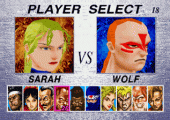
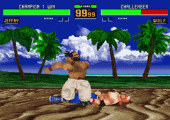
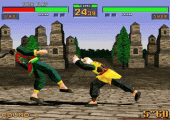
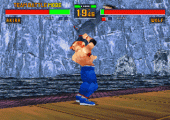
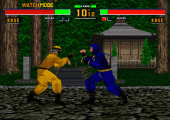
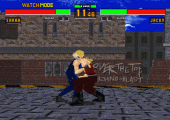
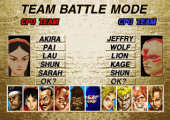
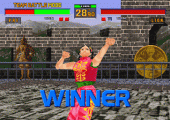
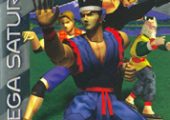
Recent Comments